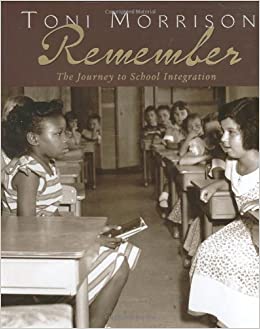Remember: The Journey to School Integration
Remember: The Journey to School Integration is a fictional story with historic background and photographs depicting students during the period of integration written by By Toni Morrison. This book awarded Coretta Scott King Award. [1] Toni Morrison is a master storyteller. Her groundbreaking novel Beloved won the 1988 Pulitzer Prize in fiction. In 1993 she became the first black woman to receive the Nobel Peace Prize in Literature. Toni Morrison is currently the Robert F. Goheen Professor of Humanities at Princeton University. Remember is her first historical work for young people. [2]
Plot
Toni Morrison’s look at school desegregation in the 1950s and the civil rights movement that followed is all about people: those who put themselves on the line to correct unfairness, to challenge accepted values, and to change the way things were, as well as all of us who benefit from those changes today. The photographs and spare text invite us to put ourselves into this era of change and understand how it felt. [3] Assembling more than 50 photographs depicting segregation, school scenes, and events prior to and following the 1954 Supreme Court ruling on Brown v. Board of Education, Morrison (Who's Got Game? ) writes that "because remembering is the mind's first step toward understanding," her book is designed to take readers "on a journey through a time in American life when there was as much hate as there was love." [4]
Controversy
Morrison is careful to provide younger readers background on what happened during the Civil Rights struggle. Each of the three sections begins with information providing context for the pictures. The first section—“The Narrow Gate”– opens with a picture of black children in a segregated school and one little girl standing and reading out loud. The text next to the photo reads “The law says I can’t go to school with white children. Are they afraid of my socks, my braids? I am seven years old. Why are they afraid of me?” Most of the other images in this section show assorted segregated classrooms. It concludes with a photo of two girls walking along a railroad track to school in Topeka, Kansas. This picture is followed by the book’s second section, called “The Open Gate,” which deals directly with attempts at integration. There is first a picture of the New York Times’ front page announcing the Brown vs. Board of Education decision. On the facing page is a photo of the Supreme Court. A number of the pictures are disturbing. A little white boy in a Klan outfit leaning out a car window. Three white men chasing a black man down a street. White crowds haranguing black students. Two students fighting on a sidewalk. A white restaurant owner, his cigarette hanging from the corner of his mouth, throwing water on protesters. The book’s third section, “The Open Gate,” also features photos of acts of protest and white counterprotest that were part of the Civil Rights movement, but an increasingly hopeful note emerges as we move towards the book’s conclusion. This is the section that includes photos of Martin Luther King and Rosa Parks. [5]
References
- ↑ Remember: A Journey to School Integration. History Explorer. Retrieved February 1 2021.
- ↑ Remember by Toni Morrison. Houghton Mifflin Books. Retrieved February 1 2021.
- ↑ Remember by Toni Morrison. Houghton Mifflin Books. Retrieved February 1 2021.
- ↑ REMEMBER: The Journey to School Integration. Publisher Weekly. Retrieved February 1 2021.
- ↑ Toni Morrison’s “Remember: The Journey To School Integration.”. Buckeymuse. Retrieved 1 February 2021.
